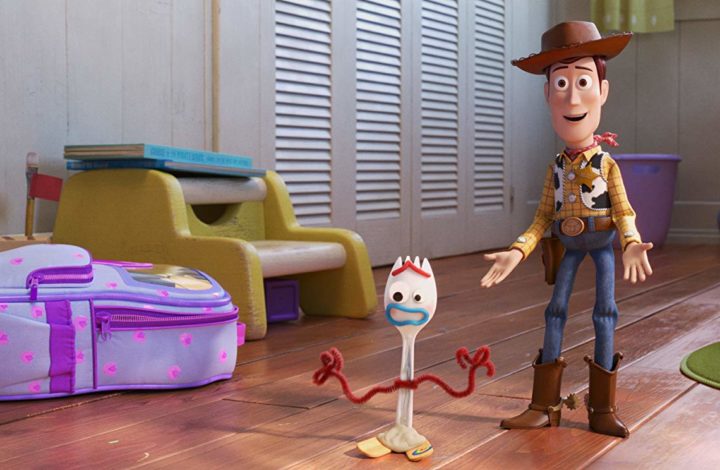
MPAA Rating: G | Rating: ★★★
Release year: 2019
Genre: Adventure, Animated, Comedy Director: Josh Cooley
Like its toys, Toy Story 4 has an identity problem: it doesn’t quite know what it is or what gives it meaning and worth. That’s a harsh Sid-ister opening statement to make about a beloved Pixar series which has given us some of the best animated films of all time. Yet it’s appropriate for this odd and scattered fourth film tacked on to a trilogy which was satisfactorily completed with Toy Story 3. Even as it features some of the funniest jokes and most exquisitely detailed animation in a Pixar film to-date, this new adventure with Woody (Tom Hanks) and Buzz (Tim Allen) raises plenty of strange ontological questions about the toys’ existence and purpose while giving less-than-satisfying answers.
First, the fun. Andy’s old toys are making adjustments to their new life with the spunky Bonnie (Madeleine McGraw). As she nervously heads into kindergarten, Woody hops along to help bring her comfort on her first day of orientation. She makes a new friend (literally) by wrapping pipe cleaner and gluing googly eyes to a plastic spork that Woody fished out of the trash bin. What emerges is Forky (Tony Hale), a Frankenstein’s monster of a toy born with an existential crisis: he thinks he’s trash, but Woody insists he’s Bonnie’s toy; he bears her name on his foot/popsicle sticks, and thus is deemed as important. Yet he continually tries to throw himself away, seeking to be discarded with the zeal of a religious fundamentalist. It’s darkly hilarious as Forky’s semi-suicidal tendencies and awkward bodily movements–his pipe cleaner arms are always falling off–keep Woody and the other toys on their toes.
Now, the creation of Forky in Toy Story 4 raises all sorts of metaphysical questions about the nature of toyhood. The significance of having the kid’s name inscribed upon a toy is akin to the imago dei in Christian theology, that human beings are unique in bearing the image of God. But can anything become sentient if it’s used as a “toy” by a child? Are paper airplanes living beings upon being folded, then suddenly killed when crumpled and tossed into the garbage? Do rocks and sticks have existential crises every time they’re picked up by a child and used in imaginative play? Why aren’t crayons or video games alive in the same way? Toy Story 4 raises such philosophical world-building questions without bothering to necessarily answer them; we just know that Forky is, and thus becomes the MacGuffin which drives the convoluted plot of the film.
The plot and themes feel a lot like its toys: lost and unsure of an identity. Though Woody is driven to keep Forky alive as a toy and in Bonnie’s grasp, this ends up becoming secondary to Woody’s relationship with Bo Peep (Annie Potts), who was inexplicably absent from Toy Story 3. This film opens with a prologue explaining her disappearance, while the Quest for Forky ultimately leads Woody and Co. to an antique store near a traveling carnival where Bo has embraced her newfound identity as a lost toy. We meet all sorts of other new toys at these two locations, from the hilarious carnival plush toy(s) Ducky and Bunny (Keegan-Michael Key and Jordan Peele, respectively), to the sad and creepy 1950s-era doll Gabby Gabby (Christina Hendricks) and her army of ventriloquist dummies, as well as the incredible Canadian stuntman Duke Caboom (Keanu Reeves) and pocket-sized policewoman Giggle McDimples (Ally Maki). The voice actors and characters are top notch here, but it’s the animation which is most impressive. The antique store and carnival environments lend themselves to all sorts of creative and detailed images, especially as the toys navigate the baseboards-turned-alleyways around the antique furniture or carnival games. The rain falling in the opening prologue with Bo Peep and Woody is so lifelike that one almost forgets that this is animated. Having re-watched 1995’s original Toy Story this week, it’s striking to see how far the animation has come over the past few decades.
Despite the humor and visuals, Toy Story 4‘s conclusion is muddled and unearned. While I won’t discuss the ending in detail here, I will say that it’s a stark contrast to the affecting let’s-come-together incinerator scene of Toy Story 3, as well as the goodbye to Andy. In all the previous films, the toys’ dedication to both their child and one another was a beautiful picture of community, featuring an integration of of unity and diversity as the toys have a common mission and sense of identity even as they used their distinct talents and personalities to support that community. In Toy Story 4, that all goes out the window (literally) as the film seems to praise strict autonomy and embracing one’s “lostness” as a heroic vocation rather than a status to avoid. Where the original trilogy ended with a sense of continued hope and togetherness even as there was loss and sadness due to the end of an era, in this post-Andy apocalypse it’s every lost toy for themselves, a deconstruction of the previous mythology without offering a coherent alternative narrative. In our present era of political divides and cultural crises, a message of “leave the others and embrace your trashy lostness” is disheartening, and discontinuous with the previous Toy Story mythology. In this, Toy Story 4 is wholly superfluous, albeit often funny and nice to look at. I’m looking forward to 2020 as Pixar finally turns away from its plethora of unnecessary sequels towards something original and new: Onward and Soul.
IMDB Listing: https://www.imdb.com/title/tt1979376/
Leave a Reply